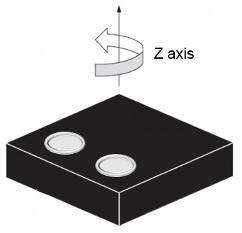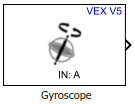Gyroscope
Represent connected gyroscope and measure yaw angle
Add-On Required: This feature requires the Simulink Coder Support Package for VEX EDR V5 Robot Brain add-on.
Libraries:
Simulink Coder Support Package for VEX EDR V5 Robot Brain /
Sensors
Description
The Gyroscope block represents a gyroscope connected to the 3-wire port of VEX V5 Robot brain, and measures the angle (in degrees) along the yaw axis of the gyroscope sensor.
The block outputs angle in degrees as a double-precision scalar value. When you rotate the gyroscope sensor in a clockwise direction, the angular increases. When you rotate the sensor in a counterclockwise direction, the value decreases.

While starting the program, do not move the robot for a couple of seconds for proper initialization of Gyroscope.
Ports
Output
Parameters
Extended Capabilities
Version History
Introduced in R2019b

